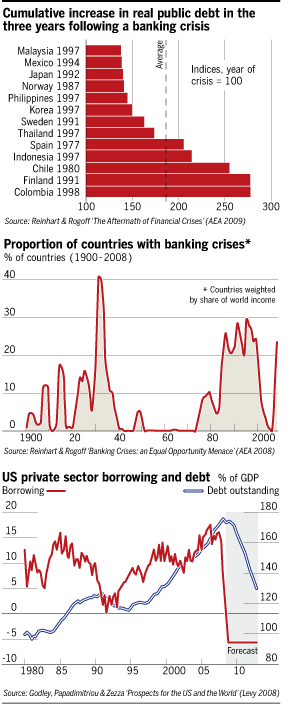Englund 2001:
U.S. Trade Deficit:
If something cannot go on for ever it will stop
News Home
Home - Index -
News - Krisen 1992 - EMU - Economics - Cataclysm -
Wall Street Bubbles
US Dollar - Subprime - Houseprices
"The US is not strong enough to rescue the world economy on its own."
The US is not strong enough to rescue the world economy on its own.
The US have, at present, structurally deficient capacity to produce tradable goods and services.
Martin Wolf, Financial Times, January 6 2009
Highly recommended
Some entertain hopes that we can restore the globally unbalanced economic growth of the middle years of this decade.
They are wrong. Our choice is only over what will replace it.
It is between a better balanced world economy and disintegration.
That choice cannot be postponed. It must be made this year.

In the big crises of recent decades, US demand has rescued the world.
This was true during the 1990s, after the Asian crisis, and again after the stock market crash of 2000.
The real value of government debt jumps, on average, by 86 per cent (see chart).
This is only in small part because of the cost of recapitalising banks.
It is far more because of collapses in tax revenues.
But who, apart from its government, will rescue the US?
And on what scale must it act?
The US and a number of other chronic deficit countries have, at present, structurally deficient capacity to produce tradable goods and services.
The rest of the world or, more precisely, a limited number of big surplus countries particularly China have the opposite.
So demand consistently leaks from the deficit countries to surplus ones.
It means that US rescue efforts need to be big enough not only to raise demand for US output but also to raise demand for the surplus output of much of the rest of the world.What has happened to US private spending follows from the collapse in borrowing: between the third quarter of 2007 and the third quarter of 2008 net lending to the US private sector fell by about 13 per cent of gross domestic product by far the steepest fall in the history of the series (see chart).
With borrowing out of the picture, private net saving the difference between income and expenditure is likely to remain positive for years, as households pay down debt, willingly or not.
Given the persistent structural current account deficit, how large does the fiscal deficit need to be to balance the economy at something close to full employment?
Assuming, for the moment, that the private sector runs a financial surplus of 6 per cent of GDP and the structural current account deficit is 4 per cent of GDP, the fiscal deficit must be 10 per cent of GDP, indefinitely.
A discretionary boost of $760bn or 5.3 per cent of GDP is not enough.
Now think what will happen if, after two or more years of monstrous fiscal deficits, the US is still mired in unemployment and slow growth. People will ask why the country is exporting so much of its demand to sustain jobs abroad. They will want their demand back.
The last time this sort of thing happened in the 1930s the outcome was a devastating round of beggar-my-neighbour devaluations, plus protectionism.
Once the integration of the world economy starts to reverse and unemployment soars, the demons of our past above all, nationalism will return. Achievements of decades may collapse almost overnight.
The US is not strong enough to rescue the world economy on its own. It needs helpers, particularly in the surplus countries. The US and a few other advanced countries can no longer absorb the world's surpluses of savings and goods.More by Martin Wolf at IntCom
http://www.internetional.se/wolfmeny.htm
Hyllningar till USA-ekonomin av Klas Eklund, Bo Lundgren och Mats Johansson
http://www.internetional.se/egoomnewera.htm#medioker